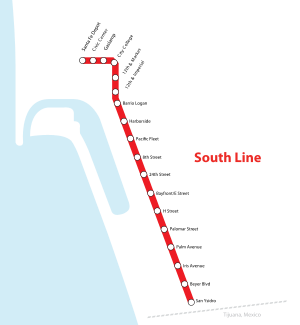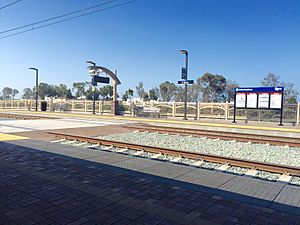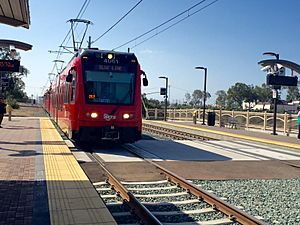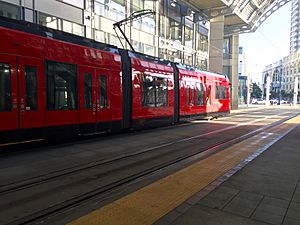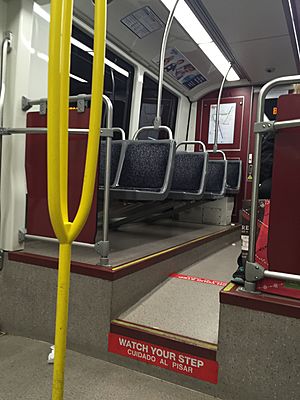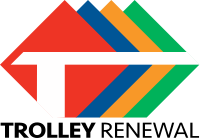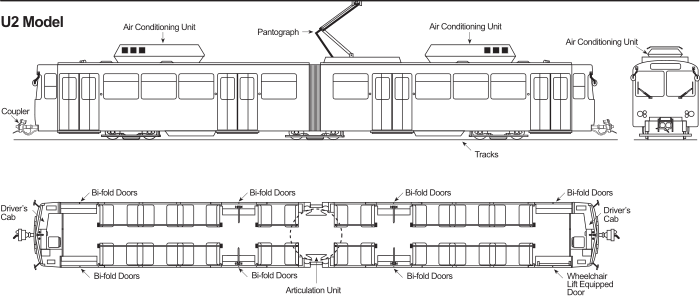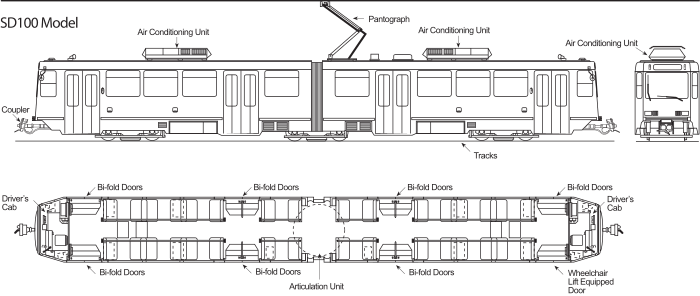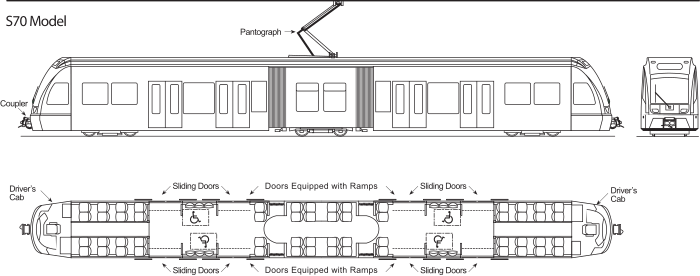San Diego Trolley facts for kids
Quick facts for kids San Diego Trolley |
|||
|---|---|---|---|
 MTSgreenline-convctr.jpg |
|||
| Info | |||
| Owner | San Diego Metropolitan Transit System | ||
| Locale | San Diego County, California, United States | ||
| Transit type | Light rail | ||
| Number of lines | 3 daily lines, 1 heritage line (limited service) | ||
| Number of stations | 62 | ||
| Headquarters | James R. Mills Building 1255 Imperial Avenue San Diego, California |
||
| Operation | |||
| Began operation | July 26, 1981 | ||
| Operator(s) | San Diego Trolley, Inc. | ||
| Number of vehicles | 128 light rail vehicles:
3 historic vehicles:
|
||
| Technical | |||
| System length | 65 mi (105 km) | ||
| Track gauge | 4 ft 8 1⁄2 in (1,435 mm) standard gauge | ||
| Electrification | Overhead line, 600 V DC | ||
| Top speed | 55 mph (89 km/h) | ||
|
|||
The San Diego Trolley (reporting mark SDTI) is a light rail system operating in the metropolitan area of San Diego. It is known colloquially as "The Trolley". The Trolley's operator, San Diego Trolley, Inc. (SDTI), is a subsidiary of the San Diego Metropolitan Transit System (MTS). The Trolley began service on July 26, 1981, making it the oldest of the second-generation light rail systems in the United States. The Trolley system serves 62 stations, comprises 65 miles (105 km) of route, three primary lines (Blue Line, Orange Line, and Green Line) that operate daily, and one heritage line (Silver Line) that operates on a circuit of downtown on select days. In 2019, the Trolley had the fifth highest ridership of light rail systems in the United States, with 23,485,700 annual rides, an average of 84,500 rides per weekday.
History
Although electric rail service in San Diego traces its roots back to 1891 when John D. Spreckels incorporated the San Diego Electric Railway, today's operating company, San Diego Trolley Incorporated (SDTI), was not founded until 1980 when the Metropolitan Transit Development Board (now operating as MTS) began planning a light-rail service along the Main Line of the San Diego and Arizona Eastern Railway (SD&AE Railway), which had been purchased by MTDB from Southern Pacific Railroad in 1979. Service began on July 19, 1981, with revenue collection beginning on July 26, 1981. 14 trains operated on a single line between Centre City or Downtown San Diego and San Ysidro, with stops in the cities of San Diego, National City, and Chula Vista.
On March 23, 1986, SDTI opened an extension east from Centre City San Diego to Euclid Avenue, along the La Mesa Branch of the SD&AE Railway – this new second line of the Trolley was then called the East Line. Service was extended along the same line to Spring Street on May 12, 1989 serving Lemon Grove, and then to La Mesa and on to El Cajon on June 23, 1989. Service from El Cajon to Santee, which does not operate along the old SD&AE right-of-way, began on August 26, 1995.
The "Bayside" extension of the Trolley in Centre City San Diego opened on June 30, 1990. The first phase of the Old Town extension, from C Street to Little Italy in Centre City San Diego, opened on July 2, 1992. The second phase of that extension, running from Little Italy to Old Town, opened on June 16, 1996.
The "Mission Valley West" SDTI extension from Old Town to Mission San Diego commenced service on November 23, 1997 – it was at this time that the former South Line and East Line of the system were renamed the Blue Line and the Orange Line, respectively. The "Mission Valley East" extension from Mission San Diego to La Mesa began operating on July 10, 2005, with the inauguration of the third line of the San Diego Trolley system, the Green Line.
Early history
The planning for the San Diego Trolley began in 1966 under the auspices of the Comprehensive Planning Organization (CPO), an intergovernmental agency of 13 cities and San Diego County. San Diego's streetcar system had been replaced with buses in 1949. In 1966 the local bus company, San Diego Transit, was facing a financial crisis and public takeover. The CPO developed a mass-transit plan to address the long-range transportation issues of the metropolitan area.
Little progress was made in the decade 1966–1975. CPO continued to research options for addressing the region's transportation needs. Several prominent stakeholders submitted their own mass-transit master plans for the region. The alternatives studied in the decade included:
- Restoration of the 1949 streetcar system for $1.3 billion
- BART-like system featuring 417 stations on a system of 284 miles (457 km) for $2–5 billion
- Elevated system featuring automatic rapid transit vehicles for $1 billion
- Short demonstration light-rail line (Airport to Downtown), for $20 million
- Express bus system on freeways
The debate between rail rapid transit and light rail was conducted without reference to any specific right-of-way or railroad tracks. The CPO's 1975 Regional Comprehensive Plan described a $1.5 billion rail-rapid transit system in San Diego featuring a system of 58 miles (93 km) and 11 lines. However, by this time, it was widely acknowledged by public officials that the BART-like system would be much more expensive than light rail. Rail rapid plans were stalled due to high costs. Proponents of the rail rapid system were concerned about the low speed of at-grade streetcar systems. Operating deficits were also a concern. A 1974 CPO study concluded that a streetcar system would incur operating deficits of $1.9 million annually. It was also understood that any BART-like system would incur substantial deficits.
The Metropolitan Transit Development Board
The creation of the Metropolitan Transit Development Board (MTDB) in 1976 with a clearly stated mission initially did not resolve differences between the many stakeholders. However, MTDB did analyze previous transit studies, and determined that the guideway system should satisfy the following principles:
- Corridor should extend a long distance and offer high-speed operation
- Low capital cost designs should be adopted, to keep the costs within an affordable range
- Construction should be at-grade with mostly exclusive right-of-way
- Operating deficits should be minimized
A feasibility study completed in 1975 identified the unit costs of guideway options, including the estimation of ‘typical section’ per-linear-foot costs for six guideway types: (1) cut-and-cover subway; (2) tunnel bore; (3) ‘aerial line’; (4) open-cut line with retaining walls; (5) sidehill berm cut line; (6) at-grade line. In addition, the MTDB's enabling legislation explicitly required the guideway system to satisfy the following criteria, consistent with the principles adopted by the Board: priority consideration shall be given to technologies available and in use; guideway system shall be capable of being brought into operation incrementally; transportation rights-of-way of public entities shall be utilized to minimize construction costs. The adoption of the principles effectively required either a ‘light rail vehicle’ capable of street running (to avoid grade separation), or a commuter-rail like design terminating at the Santa Fe Depot.
The MTDB's enabling legislation also provided a dedicated funding source for guideway construction that would expire in 1981. Urgency was created since the dedicated funding would revert to the State highway fund if not expended on mass-transit guideway construction. In 1976–77, considerable planning efforts were completed. MTDB's 1977 "Guideway Planning Project: Phase I Report" identified many alignment options: Interstate highways I-5, I-8, and I-805; State Routes 94 and 163; railroad rights-of-way owned by Santa Fe (AT&SF) and by Southern Pacific/San Diego & Arizona Eastern (SD&AE); local arterials El Cajon Boulevard, 4th/6th/Genesee Avenues, and Highland/National/3rd/5th Avenues.
This report dismissed the use of local arterials for line-haul purposes, due to the cost of aerial or tunnel guideways. "A guideway extending from El Cajon easterly (parallel to I-8) to the vicinity of I-5/Santa Fe Railroad, then southerly through Centre City to San Ysidro parallel to I-5 and SD&AE" was recommended as the first increment. As planning intensified, Phase II of the "Guideway Planning Project" was under way, with efforts initially focusing on the El Cajon Line with the higher ridership potential. However, nature intervened.
Tropical Storm Kathleen
On September 10, 1976, Tropical Storm Kathleen destroyed parts of SD&AE's Desert Line, at the time a part of the Southern Pacific (SP) system. The hurricane caused $1.3 million worth of damage, primarily in the eastern part of the state. Through freight service to Arizona was suspended and San Diego became an isolated portion of the SP system. SP petitioned for abandonment of the SD&AE on August 9, 1977, of all tracks west of Plaster City, while the MTDB guideway planning project was ongoing. Due to the apparently immediate availability of a right-of-way in the South Bay Corridor, the transit planning refocused on the SD&AE (SP) Tijuana line, making it the effective ‘minimum operable segment’.
At the same time, the San Diego County Board of Supervisors became concerned about the freight service on the SD&AE. Direct freight service to the East was seen as vital to the county's economic interests and the continued viability of San Diego as a deep-water port. With an eye towards preserving freight service and future transit right-of-way, San Diego County commissioned its own internal study effort, "Feasibility of Using Existing SD&AE ROW for Commuter Service", to examine using a portion of the SD&AE tracks for light rail or diesel passenger service sharing track with freight services. Part of the motivation for considering the SD&AE was to "operate the freight service at a profit through changes to work rules, relief from property taxes, and sharing of costs with the transit operation".
Transit alternatives
By late 1977, two major transit investment studies were under way focusing on the same corridor: the MTDB-sponsored "Guideway Planning Project", and San Diego County's "SD&AE ROW Feasibility Study".
1. The Base Case: MTDB described the base case as a modified bus network that retained the same number of total vehicles as the present San Diego Transit system.
2. MTDB's All-Bus Improvement Alternative: This "low capital cost" system would have introduced high-occupancy vehicle lanes on freeways and invested in higher capacity buses and express routes.
3. MTDB's Rail Improvement Alternative, San Diego County's "Light Rail Electric": This "medium capital cost" has electric light-rail transit replacing buses in the South Line corridor and would re-deploy the buses on feeder services.
4. MTDB's Fully Separated Rail Freight Service Alternative: MTDB examined the possibility of an exclusive double-track South Line on the SD&AE right-of-way. Under this freight rationalization proposal, freight trains would operate over the parallel Coronado Spur south to Imperial Beach, and via 2 miles (3.2 km) of new right-of-way and 5 miles (8 km) of "shared corridor" parallel operations on dedicated tracks to reach Tijuana.
5. San Diego County's "Leased Diesel" Option: The county saw the leased diesel (equivalent to present day commuter rail) as the lowest initial cost option with the least time required to begin service. Facilities would be designed to be convertible to light rail when more funds became available.
6. San Diego County's "Light Rail Diesel" Option: The county was interested in the self-powered diesel rail cars for its lower capital costs, however, noted that the vehicles were not then approved by the California Public Utilities Commission for one-person operation.
Implementation
In 1978, the MTDB successfully negotiated with SP to purchase the SD&AE for $18.1 million, including the $1.3 million required to restore the hurricane-damaged freight line. This was a dual-intent decision, to preserve both rail freight services to the Imperial Valley, and to preserve available right-of-way for future transit use. In light of cheaper light-rail options identified in the MTDB and San Diego County studies, more expensive options such as a proposed $325 million rail-rapid transit line on a new right-of-way to the border seemed less competitive. There was universal agreement that using the SD&AE right-of-way and light rail technology was more economical and practical than a new rail-rapid transit line.
Construction of the San Diego Trolley proceeded incrementally. The initial construction of new track focused mainly in downtown San Diego. The work on the SD&AE railroad track is best described as ‘rehabilitation’. The MTDB replaced 40% of all ties, cropped and welded the jointed rail, constructed electric catenaries, and installed an absolute block signal system. To control costs, the San Diego Trolley ordered only 14 cars, and did not install ‘mimic’ boards or the on-train location equipment until after the East Line was completed in 1989. No new sidings were initially installed on the SD&AE segment, which had three passing sidings between San Diego and San Ysidro. Service started at 15-minute headways using the rehabilitated single-track line.
San Diego Trolley opened in 1981 with 13.5 miles (21.7 km) of operations on the South Line. Additional vehicles were purchased in 1983, and the South Line was mostly double-tracked by 1984, largely on the strength of demand for more frequent headways. The business plan's incremental building and funding approach was vindicated. The East Line opened to Euclid Avenue in 1986, and was extended to El Cajon in 1989 and Santee in 1995. Service was extended northward to Old Town in 1996 and then eastward in Mission Valley in both 1997 and 2005.
The transit center at 12th & Imperial, in the southeastern portion of downtown San Diego, has historically been used as the transfer point between the various lines, and is located adjacent to the Trolley's maintenance facilities. It is a recognizable landmark in the neighborhood, as it includes a grey clocktower with red clock. It is located two blocks east of the main entrance to Petco Park and is the station serving that facility.
Current service
Lines
Trolley service operates on three daily lines: the Blue, Green, and Orange Lines, and travels through 53 stations and 53.5 total miles of double-track rail. A fourth line, the heritage streetcar Silver Line, operates more limited weekday and weekend service, in a clockwise 'circle-loop' around downtown San Diego only.
| Line | Opening | Length | Stations | End Points | Operation | |
|---|---|---|---|---|---|---|
| 1981 | 15.4 mi (24.8 km) | 18 | America Plaza -to- San Ysidro Transit Center |
Daily | ||
| 2005 | 23.6 mi (38.0 km) | 27 | 12th & Imperial Transit Center -to- Santee Town Center |
Daily | ||
| 1986 | 18.0 mi (29.0 km) | 19 | Santa Fe Depot -to- El Cajon Transit Center |
Daily | ||
| 2011 | 2.7 mi (4.3 km) | 9 | loops through: 12th & Imperial Transit Center | Mid-day on Selected Days | ||
Stations
The San Diego Trolley system has 53 stations serving its four Trolley lines.
Fourteen of the Trolley system's stations operate as transfer stations, which allow passengers to transfer between lines. There are two "universal" transfer points (i.e., allowing transfers among all four lines) in the system in downtown San Diego: the 12th & Imperial Transit Center station, and the America Plaza/Santa Fe Depot stations. Six Trolley stations are end-of-line stations. Of the 53 San Diego Trolley stations, 37 stations are within the city limits of San Diego, serving various neighborhoods in San Diego; the other 16 stations are located in the cities of Chula Vista, El Cajon, La Mesa, Lemon Grove, National City, and Santee.
Most of the stations in the San Diego Trolley system are 'at-grade' stations. There are 8 aerial stations, mostly on the newer Green Line. There is just one Trolley station in the system that is underground – the SDSU Transit Center station – also on the Green Line.
Approximately a little less than half of San Diego Trolley stations offer free parking (i.e. Park & Ride). Most Trolley stations offer connections to MTS bus lines.
Hours of operation
The San Diego Trolley's three main lines operate regular service between 5am and midnight, seven days a week. Limited service on particular segments is provided before 5am and after midnight, however; but there is no rail service between 2am and 3:30am. During these hours when there is no passenger service, freight trains of the San Diego and Imperial Valley Railroad operate on the trolley's right of way.
Service on the Blue Line operates every 15 minutes, seven days a week, with service every 7.5 minutes during weekday rush-hours; late-night service on this line runs every 30 minutes. The Green and Orange Lines operate service every 15 minutes on Monday-Saturday mid-days, but every 30 minutes on weekend mornings, on Sundays, and during evenings.
Fares and fare collection
The fare for a standard one-way Trolley ticket is $2.50, and one-way tickets are good for two hours from the time of purchase. Transfers between trolley lines are free, provided it is to complete the one-way trip; but round-trips are not allowed on a one-way ticket. Transfers to MTS/NCTD buses, the Coaster and the Sprinter are also not free with a standard one-way Trolley ticket. However, a Day Pass (good for one calendar day) is unlimited use, and allows unlimited travel on the San Diego Trolley system for that day, as well as most MTS & NCTD bus systems, and the north country Sprinter light rail service. A RegionPlus Day Pass allows unlimited service on all of the above named systems, as well as MTS Premium buses and the Coaster commuter rail, for one calendar day.
The following table shows San Diego MTS fares, effective September 1, 2008 (in US dollars):
| Fare Type | Regular | Senior Disabled Medicare |
|---|---|---|
| Local, Urban & Shuttle Bus Lines – One-Way | $2.25 | $1.10 |
| Express Bus Routes – One-Way | $2.50 | $1.25 |
| Bus Token (One-Way) | $2.50 | $2.50 |
| San Diego Trolley – One-Way Ticket | $2.50 | $1.25 |
| Regional Day Pass | $5 | $5 |
| RegionalPlus Day Pass | $12 | $12 |
| Regional 2-Day Pass | $9 | $9 |
| Regional 3-Day Pass | $12 | $12 |
| Regional 4-Day Pass | $15 | $15 |
| Regional 14-Day Pass | $43 | $43 |
| Premium 14-Day Pass | $60 | $60 |
| Regional Monthly Pass | $72 | $18 |
| Premium Monthly Pass | $100 | $25 |
Fare collection is based on a proof-of-payment system. The San Diego Trolley is a barrier-free (no turnstiles), self-service system. Patrons must have proof of fare (ticket or pass) before boarding. Self-serve ticket vending machines are located at each station. Compass Card (see below) users must "tap" at a Compass Card validator (located at various points around each Trolley station, and on MTS buses) or on the Compass Card target on a ticket vending machine before boarding a trolley. Random fare inspections are performed by roving transit enforcement personnel. Based on frequent security inspections, nearly 98% of the 37 million patrons have proper fares.
Compass cards
The Compass Card is a form of electronic ticketing used on public transport services within San Diego County, California. It is administered by the San Diego Association of Governments (SANDAG) and is valid for travel on a number of different transit systems within San Diego County including MTS buses, the San Diego Trolley, North County Buses, the Coaster commuter rail line and the SPRINTER (a light rail line in north San Diego County). The card and fare collection systems are manufactured by Cubic Transportation Systems, and SANDAG administers the Compass Call Center (CCC), a central call center for all agencies.
The Compass Card is an orange or yellow, credit-card-sized contactless smartcard which can hold a transit pass, such as a Day Pass, a 14-Day Pass, etc. The Compass Card card must tapped on an electronic Compass Card validator when entering and transferring within the system in order to validate the fare. Compass Card readers are integrated in bus fareboxes, and standalone readers are located just outside the paid-area of Trolley and rail stations.
Ridership
| Average Weekday Ridership | |||
|---|---|---|---|
| Year | Quarter | Ridership | %± |
| 1996 | Q1 | 47,000 | — |
| 1996 | Q2 | 47,300 | +0.6% |
| 1996 | Q3 | 53,500 | +13.1% |
| 1996 | Q4 | 46,800 | –12.5% |
| 1997 | Q1 | 52,000 | +11.1% |
| 1997 | Q2 | 56,400 | +12.3% |
| 1997 | Q3 | 60,300 | +3.3% |
| 1997 | Q4 | 57,400 | –4.8% |
| 1998 | Q1 | 69,400 | +20.9% |
| 1998 | Q2 | 77,300 | +11.4% |
| 1998 | Q3 | 71,000 | –8.2% |
| 1998 | Q4 | 69,300 | –2.4% |
| 1999 | Q1 | 63,300 | –8.7% |
| 1999 | Q2 | 72,800 | +15.0% |
| 1999 | Q3 | 79,000 | +8.5% |
| 1999 | Q4 | 81,300 | +2.9% |
| 2000 | Q1 | 85,600 | +5.3% |
| 2000 | Q2 | 88,000 | +2.8% |
| 2000 | Q3 | 94,300 | +7.2% |
| 2000 | Q4 | 82,600 | –12.4% |
| 2001 | Q1 | 79,600 | −3.6% |
| 2001 | Q2 | 82,600 | +3.8% |
| 2001 | Q3 | 78,800 | −4.6% |
| 2001 | Q4 | 71,600 | −9.1% |
| 2002 | Q1 | 71,100 | −0.7% |
| 2002 | Q2 | 77,200 | +8.6% |
| 2002 | Q3 | 74,400 | −3.6% |
| 2002 | Q4 | 71,300 | −4.2% |
| 2003 | Q1 | 73,100 | +2.5% |
| 2003 | Q2 | 74,700 | +2.2% |
| 2003 | Q3 | 76,700 | +2.7% |
| 2003 | Q4 | 70,100 | −8.6% |
| 2004 | Q1 | 74,700 | +6.6% |
| 2004 | Q2 | 88,400 | +18.3% |
| 2004 | Q3 | 94,500 | +6.9% |
| 2004 | Q4 | 81,700 | −13.5% |
| 2005 | Q1 | 80,000 | −2.1% |
| 2005 | Q2 | 94,200 | +17.8% |
| 2005 | Q3 | 104,900 | +11.4% |
| 2005 | Q4 | n/a | n/a |
| 2006 | Q1 | 95,800 | — |
| 2006 | Q2 | 100,900 | +5.3% |
| 2006 | Q3 | 107,300 | +6.3% |
| 2006 | Q4 | 105,100 | −2.1% |
| 2007 | Q1 | 96,700 | −8.0% |
| 2007 | Q2 | 107,000 | +10.7% |
| 2007 | Q3 | 124,300 | +16.2% |
| 2007 | Q4 | 118,400 | −4.7% |
| 2008 | Q1 | 98,700 | −16.6% |
| 2008 | Q2 | 113,300 | +14.8% |
| 2008 | Q3 | 114,900 | +1.4% |
| 2008 | Q4 | 103,900 | −9.6% |
| 2009 | Q1 | 96,000 | −8.1% |
| 2009 | Q2 | 93,300 | −2.3% |
| 2009 | Q3 | 93,100 | −0.2% |
| 2009 | Q4 | 91,200 | −2.0% |
| 2010 | Q1 | 86,100 | −5.6% |
| 2010 | Q2 | 94,700 | +10.0% |
| 2010 | Q3 | 92,100 | −2.7% |
| 2010 | Q4 | 90,000 | −2.3% |
| 2011 | Q1 | 98,000 | +8.9% |
| 2011 | Q2 | 96,800 | −1.2% |
| 2011 | Q3 | 133,400 | +37.8% |
| 2011 | Q4 | 103,400 | −22.5% |
| 2012 | Q1 | 96,900 | −6.3% |
| 2012 | Q2 | 94,300 | −2.7% |
| 2012 | Q3 | 95,700 | +1.5% |
| 2012 | Q4 | 87,700 | −8.4% |
| 2013 | Q1 | 80,100 | −8.7% |
| 2013 | Q2 | 89,400 | +11.6% |
| 2013 | Q3 | 121,900 | +36.4% |
| 2013 | Q4 | 122,400 | +0.4% |
| 2014 | Q1 | 120,600 | −1.5% |
| 2014 | Q2 | 120,100 | −0.4% |
| 2014 | Q3 | 124,100 | +3.3% |
| 2014 | Q4 | 119,800 | −3.5% |
| The weekday average ridership figure for the San Diego Trolley from the Q3 2011 APTA Report is likely a typo, based on the other ridership figures for that Quarter – it is more likely that Q3 2011 figure is supposed to be 103,400. | |||
| The extension from Little Italy to Old Town opened in late-Q2 1996. The "Mission Valley West" extension from Old Town to Mission San Diego open in mid-Q4 1997. The "Mission Valley East" extension from Mission San Diego to La Mesa, along with the accompanying inauguration of the Green Line, opened in mid-Q3 2005. |
|||
| Source: | |||
As of the Fourth Quarter (Q4) of 2013, the average weekday ridership on the San Diego Trolley system was 119,800, making it the fourth busiest Light rail system in the United States. Taking overall track length into consideration, the San Diego Trolley transported 2,239 daily passengers per route mile in Q4 2014, making it the twelfth busiest Light rail system on a per mile basis over this time period. Weekday ridership on the Trolley has been relatively high since Q3 2013 (see table at right).
In all of 2014, the San Diego Trolley provided 39,731,900 unlinked passenger transits according to the American Public Transportation Association (APTA). MTS reported that there were 39,694,197 trips on the Trolley in Fiscal Year 2014 (FY 2014), a 34% increase over Fiscal Year 2013. Of the Trolley's three lines, the Blue Line has the system's highest ridership with 15,094,878 riders during FY 2014, followed by the Green Line with 13,673,926 FY 2014 riders, and the Orange Line with 10,896,289 FY 2014 riders. The Silver Line, operating only mid-days just four days a week (and with some service interruptions during the year), carried 29,104 passengers around the downtown loop in FY2014.
The following ridership data for the San Diego Trolley was obtained from the American Public Transportation Association's (APTA) Ridership Report Archives:
| Year | Total Unlinked Passenger Trips on San Diego Trolley system for That Total Year |
|---|---|
| 2004 | 28,772,400 |
| 2005 | 32,132,400 |
| 2006 | 34,380,500 |
| 2007 | 36,386,100 |
| 2008 | 36,054,600 |
| 2009 | 31,337,500 |
| 2010 | 30,514,700 |
| 2011 | 32,748,700 |
| 2012 | 31,206,900 |
| 2013 | 34,448,900 |
| 2014 | 39,731,900 |
According to figures from APTA, previous to 2014, the San Diego Trolley achieved the highest level of ridership in 2007, when there were 36,386,100 unlinked passenger transits on the system over that entire year. The Trolley system's highest average weekday ridership of 124,300 was achieved in Q3 2007 – this corresponded to 2,323 passengers per route mile daily.
Future service plans
Trolley Renewal Project
On September 24, 2009, MTS approved the purchase of 57 new model Siemens S70 cars, at a total cost of $205 million. The cars began arriving in late September 2011 and are custom made model S70s. In 2012, the order was increased from 57 to 65 of these 'streetcar length' S70s. The new vehicles are nine feet (2.74 m) shorter than the existing S70 vehicles on the system, making them the equivalent size of the older SD100 "Boxed Shaped" cars, allowing for three car operation in the downtown area. In order to run these trolleys on the older Orange and Blue Lines a platform and tracks renovation project was begun in 2010, starting with Blue Line stations south of Old Town, working its way southbound.
The project entailed raising the station from a track level (0-inch or 0-millimeter) or 4-inch (102 mm) raised platform to a 6-inch (152 mm) raised platform and placing a special "safety tile" with a smooth surface in the center, on the curb to allow for the wheelchair ramps to deploy without being damaged, as the existing "safety tile" contains rivets all the way throughout it. Some stations, primarily south of 12th and Imperial on the Blue Line, continued to board at track level through early 2015, and major re-construction was needed before low-floor trolleys could operate at these stations. Such improvements included brand new station platforms, station structures, rails, switches, signals, and overhead wires.
In addition to new LRVs, San Diego Trolley also slowly retrofitted the SD-100s LRVs with new paint, door sensors & switches, wheelchair lifts, route display signs, and interior & exterior lighting. The oldest model U2 trolleys had very little that can be done to improve their functionality or operation as they lacked the overhead equipment compartments found in the SD-100s and S70s, and were planned to be entirely phased out and retired by 2015. Eleven of the U2 cars were sold to the upstart Metrotranvía Mendoza in Mendoza, Argentina; another 29 had been retired by early 2013, and the rest of the U2 trolleys were retired from service in January 2015. Four U2 cars have been preserved: car 1019 at the Rockhill Trolley Museum, car 1008 at the Orange Empire Railway Museum, as well as cars 1017 and 1018 at the Western Railway Museum.
The project cost around $660 million. The new LRVs began arriving in late September 2011 and began running on the Green Line on October 3, 2011. Additional new LRVs began operation on the Orange line in January 2013. The final phase of the project began July 25, 2013 with a groundbreaking ceremony to kick off the construction to modernize the remaining unrenovated stations on the portion of the Blue Line south of downtown San Diego. The low-floor Siemens S70 trolleys began operation on the Blue Line on January 27, 2015, which coincided with the retirement of the last of the original U2 trolleys. The project, including remaining station and track renovations, was completed in late 2015.
September 2012 Realignment Change
On September 2, 2012, MTS realigned trolley operations to allow for "more efficient travel" and to solve several issues with the previous operating layout. The Green Line was extended from its former western terminus in Old Town south to 12th & Imperial Transit Center's Bayside Terminal, eliminating the need for the Special Event Service Line, which previously ran on a similar route. The Orange Line's western terminus was extended to Santa Fe Depot while its eastern terminus was shortened to El Cajon Transit Center due to the line's low ridership to and from the Gillespie Field station. The Blue Line's northern terminus was temporarily shortened to America Plaza until the completion of the Mid-Coast Trolley extension project. Not only does this plan ensure every line will stop or pass through downtown, but it also creates two "universal" transfer points, one at the 12th & Imperial Transit Center (at the east side of downtown) and the other at the America Plaza/Santa Fe Depot (on the west side of downtown).
Mid-Coast Trolley extension project
SANDAG is planning an extension of the Blue Line from the Old Town Transit Center 11 miles (17.7 km) to the University City community, which will serve major activity and employment centers such as the University of California, San Diego (UCSD) campus and University Towne Centre (UTC) shopping center. This is part of the "Mid-Coast Corridor Transit Project". Construction is scheduled to begin in the second half of 2015, and the Mid-Coast extension is slated to be completed and in operation by 2021.
After the Mid-Coast Trolley extension project is completed, the Blue Line will be extended north from its current northern terminus at America Plaza to run through 5 existing stations (up to and including the Old Town Transit Center), 8 new stations (Tecolote Road, Clairemont Drive, Balboa Avenue, Nobel Drive, VA Medical Center, UCSD West/Pepper Canyon, UCSD East/Voigt Drive, and Executive Drive), and then terminate at University Towne Center in the University City/UCSD area.
Proposed Balboa Park streetcar line
MTS began work in March 2011 on a study to evaluate the feasibility of reconnecting Balboa Park, the San Diego Zoo and Downtown San Diego through a fixed-guideway, electrified streetcar line – the final study on the subject was published in October 2012. The project study corridor runs between the City College Trolley Station area, and Balboa Park in the vicinity of the San Diego Zoo. An alignment similar to the proposed one was last served by a streetcar system in 1949 on lines 7 (Park Boulevard-University Avenue to East San Diego) & 11 (Park Boulevard-Adams Avenue to Kensington). The Committee evaluated what types of streetcars to use for this proposed line, the possible options including the recently ordered 57 Ultra Short 2011 S70s in the "Modern Streetcar" category, and the restored PCC Streetcars from the Downtown Silver Line in the "Vintage Streetcar" category. The major construction issue was how to cross I-5 without having to reconstruct the entire bridge. The estimated cost for construction of this line was $68.2 million, with each trolley car estimated to cost between $850,000 (for a restored PPC trolley car) to $3.6 million (for a modern trolley car). Four cars are anticipated for service on this line. No funding sources were identified. No further action on this proposal has taken place since the October 2012 release of the study.
Potential airport extension
Since 2009, SANDAG has proposed a plan that would bring trolley service to Lindbergh Field. On January 19, 2013, mayor Bob Filner endorsed the idea, which spawned a renewed city interest in the project. In January 2013, SANDAG took steps to bring about a proposed extension to the Airport; MTS also had this idea in consideration for many years. One scenario of the plan would be an extension of the existing Orange Line from downtown to the southern portion of Lindbergh Field along Harbor Drive that would connect the Airport's terminals to trolley service. Another proposed scenario would bring service to the northern portion of the Airport and connect with the Blue and Green Lines at Washington Street and/or Old Town in the near or distant future. The California High-Speed Rail line is also planned to terminate on the north side of the airport (in Phase 2, which has no timetable yet). There is no projected completion date for this proposed airport extension.
A dedicated local bus line (Route 992) currently provides a connection between the airport terminals and downtown.
2050 Regional Transportation Plan
The San Diego Association of Governments (SANDAG) released a draft of its 2050 Regional Transportation Plan in April 2011, which was approved by the SANDAG Board of Directors on October 28, 2011. Significant expansion of 156 new miles of Trolley service is proposed in the 2050 RTP, as well as the creation of three new streetcar lines serving Downtown San Diego.
The following Trolley and streetcar projects were included in the 2050 Regional Transportation Plan. The Plan's projected date of completion of each project is shown, but these dates are highly speculative since no specific commitments are being made in this plan, with the exception of the Blue Line Mid-Coast Extension which is currently under development.
| Project Name | Transit Type |
Route Number |
Route / Description | Projected Cost (in $mil) |
Projected Completion Date |
Status (as of Oct 2014) |
|---|---|---|---|---|---|---|
| Mid-Coast Trolley Extension (extension of Blue Line) |
Light rail | 510 | Extends the Blue Line from America Plaza, through Santa Fe Depot and Old Town Transit Center, north to UCSD and University Towne Center (UTC). | $1,642 | 2019 | Final SEIS/SEIR |
| Streetcar 'Loop' Line (Silver Line extension(?)) |
Streetcar | 554 | A new streetcar 'Loop', from Downtown San Diego through Balboa Park to Hillcrest, and back. This might be an extension of the Silver Line, or more likely a supplemental line. An initial study was done of just an extension to Balboa Park and back in October 2012. | $284 | 2020 | Under Study |
| UTC to Mira Mesa Trolley (extension of Route 510 – Blue Line) |
Light rail | 561 | A new Trolley line, that's effectively another extension of the Blue Line, from UTC Transit Center northeast to Mira Mesa, via Sorrento Mesa and Carroll Canyon. | $1,556 | 2030 | Planning |
| Streetcar Line 2 | Streetcar | 553 | New streetcar line from the Little Italy neighborhood of San Diego to the East Village neighborhood of San Diego. | $187 | 2030 | Planning |
| Mid-City Trolley (Phase 1) |
Light rail | 560 | A Trolley line running between Downtown San Diego and the Mid-City neighborhood of San Diego, via Park Blvd and El Cajon Blvd. | $4,009 | 2035 | Planning |
| Pacific Beach to El Cajon Trolley |
Light rail | 563 | A mostly east-west Trolley line running between Pacific Beach and El Cajon, via Clairemont, Kearny Mesa, Mission Valley, SDSU. (Route: Possibly along Balboa Ave. and I-15?...) | $1,978 | 2035 | Planning |
| Streetcar Line 3 | Streetcar | 555 | New streetcar line from 30th Street to Downtown San Diego, via North Park and Golden Hill. | $397 | 2035 | Planning |
| Mid-City Trolley (Phase 2) |
Light rail | 560 | Completion of the Route 560 Trolley line by extending it from the Mid-City neighborhood of San Diego to the SDSU Transit Center – the result would be a Trolley Line that runs directly between Downtown San Diego and SDSU. | $4,009 | 2050 | Planning |
| UTC To San Ysidro Trolley (east, inland/non-coastal line) |
Light rail | 562 | Trolley line from UTC to San Ysidro (second route) via Kearny Mesa, Mission Valley, Mid-City, Southeastern San Diego, and National City and Chula Vista via Highland Ave/4th Avenue. (Route: Along, or paralleling, I-805 and I-15.) | $6,043 | 2050 | Planning |
| Downtown Trolley Tunnel | Light rail | Building a downtown underground Trolley Tunnel, between 12th & Imperial Transit Center and the County Center/Little Italy Trolley station. | $4,293 | 2050 | Planning |
A related project to these is the plan to build an Airport Intermodal Transit Center on the northeast side of Lindbergh Field by 2035, which would include direct Trolley service access (from the Green Line, and from the Blue Line as well after the completion of the Mid-Coast Transit project) to San Diego International Airport. (Note: This is unrelated to the separate proposal to extend the Orange Line along Harbor Drive to the terminals on the south side of Lindbergh Field.)
Other Trolley projects in the 2050 Regional Transportation Plan involve more grade separations (from street crossings) for the Blue and Orange Lines, and the creation of more Express Lines on existing track.
Fleet specifications
Below are the technical specifications of the system's four different models of light rail vehicles, as shown on the website of the MTS.
| Specification | U2 Model (no longer in service) | SD100 Model | S70 (Full Length) Model | S70 (Streetcar Length) Model |
|---|---|---|---|---|
| Manufacturer | Duewag (with assistance from Siemens; Düsseldorf, West Germany and Florin, California) | Siemens (Florin, California) | Siemens (Florin, California) | Siemens (Florin, California) |
| Type | Double-ended articulated car, 6 axle, multiple-unit operation to 5 cars. | Double-ended articulated car, 6 axle, multiple-unit operation to 5 cars. | Double-ended articulated car, 6 axle, multiple-unit operation to 5 cars. | Double-ended articulated car, 6 axle, multiple-unit operation to 5 cars. |
| Fleet Size | 0 (originally 71 – 11 Units sold to Metrotranvía of Mendoza in 2010, remainder retired as of January 26, 2015[update]). | 52 | 11 | 65 |
| Car Nos. | 1001–1071 | 2001–2052 | 3001–3011 | 4001–4065 |
| First Purchase | 1980 | 1993 | 2004 | 2012 |
| Height (top of car to rail) |
12.4 feet (3,780 mm) | 12.4 feet (3,780 mm) | 12.4 feet (3,780 mm) | 12.4 feet (3,780 mm) |
| Center Aisle Floor Height | 39 inches (991 mm) | 39 inches (991 mm) | 15 inches (381 mm) | 15 inches (381 mm) |
| Width (exterior) | 8.7 feet (2,652 mm) | 8.7 feet (2,652 mm) | 8.7 feet (2,652 mm) | 8.7 feet (2,652 mm) |
| Length (end to end) | 76 feet (23.165 m) | 76.71 feet (23.381 m) | 88.5 feet (26.975 m) | 79.2 feet (24.140 m) |
| Length (over coupler faces) |
79.67 feet (24.283 m) | 81.36 feet (24.799 m) | 90.7 feet (27.645 m) | 81.4 feet (24.811 m) |
| Weight (empty) | 77,161 pounds (35,000 kg) | 89,000 pounds (40,370 kg) | 97,900 pounds (44,407 kg) | 96,000 pounds (43,545 kg) |
| Car Body | Lightweight welded steel, reinforced fiberglass covers articulation and operator cab portion. | Lightweight welded steel. | Low alloy high tensile steel and composite materials. | Low alloy high tensile steel and composite materials. |
| Interior | Upholstered neoprene foam (fire-resistant) seat. Rubber flooring. Simulated wood paneling. | Upholstered neoprene foam (fire-resistant) seat. Rubber flooring. Simulated wood paneling. | Cloth-covered loam seats (fire-resistant), rubber flooring, color-coordinated paneling. | Cloth-covered loam seats (fire-resistant), rubber flooring, color-coordinated paneling. |
| Wheels | Steel-tired with acoustic dampening. | Steel-tired with acoustic dampening. | Steel-tired with acoustic dampening. | Steel-tired with acoustic dampening. |
| Dynamic Braking | Primary method of stopping car. Fades when speed reduced to approx. 1⁄2–3 miles per hour (0.8–4.8 km/h). Friction braking completes the stop. Traction motors operate as generators. Full dynamic braking from 50 to 3 miles per hour (80.5 to 4.8 km/h). | Primary method of stopping car. Fades when speed reduced to approx. 1⁄2–3 miles per hour (0.8–4.8 km/h). Friction braking completes the stop. Traction motors become generators. Full dynamic braking from 55 to 3 miles per hour (88.5 to 4.8 km/h). | Primary method of stopping car. Fades when speed reduced to approx. 1⁄2–3 miles per hour (0.8–4.8 km/h). Friction braking completes the stop. Traction motors become alternators. Full dynamic braking from 55 to 1⁄2 mile per hour (88.5 to 0.8 km/h). | Primary method of stopping car. Fades when speed reduced to approx. 1⁄2–3 miles per hour (0.8–4.8 km/h). Friction braking completes the stop. Traction motors become alternators. Full dynamic braking from 55 to 1⁄2 mile per hour (88.5 to 0.8 km/h). |
| Ventilation (cooling and heating unit on entire fleet) | Dynamic air pressure allowing an exchange rate of not less than 20 times per hour. | Dynamic air pressure allowing an exchange rate of not less than 20 times per hour. | Interior air-conditioning and heating to accommodate local climate. | Interior air-conditioning and heating to accommodate local climate. |
| Speed | 50 miles per hour (80.5 km/h) maximum | 55 miles per hour (88.5 km/h) maximum | 55 miles per hour (88.5 km/h) maximum | 55 miles per hour (88.5 km/h) maximum |
| Overhead Traction Power | 600 V DC | 600 V DC | 600 V DC | 600 V DC |
| Operating Power Requirements | 500 kW to accelerate from a stationary position. 150 kW needed to maintain speed. | 550 kW to accelerate from a stationary position. 165 kW needed to maintain speed. | 130 kW to maintain speed. | 130 kW to maintain speed. |
| Passenger Capacity | Seated: 64 Commute: 96 Special Events: 150 |
Seated: 64 Commute: 96 Special Events: 150 |
Seated: 64 (52 with wheelchairs) Commute: 104 Special Events: 200 |
Seated: 60 (52 with wheelchairs) Commute: 102 Special Events: 150 |
| Doors – 8 per car | Individually activated by passenger pushing button after locks released by operator. One for wheelchair lift; low level stair boarding through double-folding doors. | Opened by operator and/or Individually activated by passenger pushing button after locks released by operator. One for wheelchair lift; low level stair boarding through double-folding doors. | Opened by operator and/or Individually activated by passenger pushing button after locks released by operator. All center sliding doors comply with ADA requirements; low-floor boarding through sliding doors. | Opened by operator and/or Individually activated by passenger pushing button after locks released by operator. All center sliding doors comply with ADA requirements; low-floor boarding through sliding doors. |
| Door Safety System | Includes photo-electric cells and sensitive door leaf edges, weight sensor on lower step. | Photo-electric cells and sensitive door leaf edges. | Photo-electric cells and sensitive door leaf edges. | Photo-electric cells and sensitive door leaf edges. |
| Wheelchair Lifts | Located at one dedicated door at one end of each vehicle. | Located at one dedicated door at one end of each vehicle. | Bridge plates/ramps on 2 designated doors per car side. | Bridge plates/ramps on 2 designated doors per car side. |
In addition, one heritage (1946) Presidents Conference Committee (PCC) streetcar, Car 529, has been operating on the Silver Line since its opening in 2011; a second restored (1946) PCC streetcar, Car 530, entered service on the Silver Line in March 2015.
Floor plans
Below are the floor plans of the system's three different models of light rail vehicle, as shown on the website of the MTS.
Images for kids
See also
 In Spanish: Tranvía de San Diego para niños
In Spanish: Tranvía de San Diego para niños



